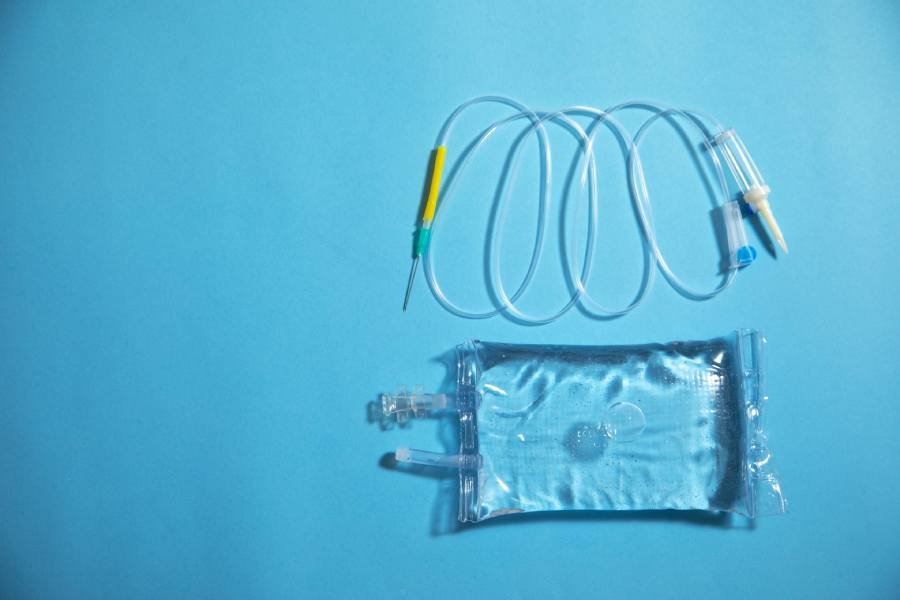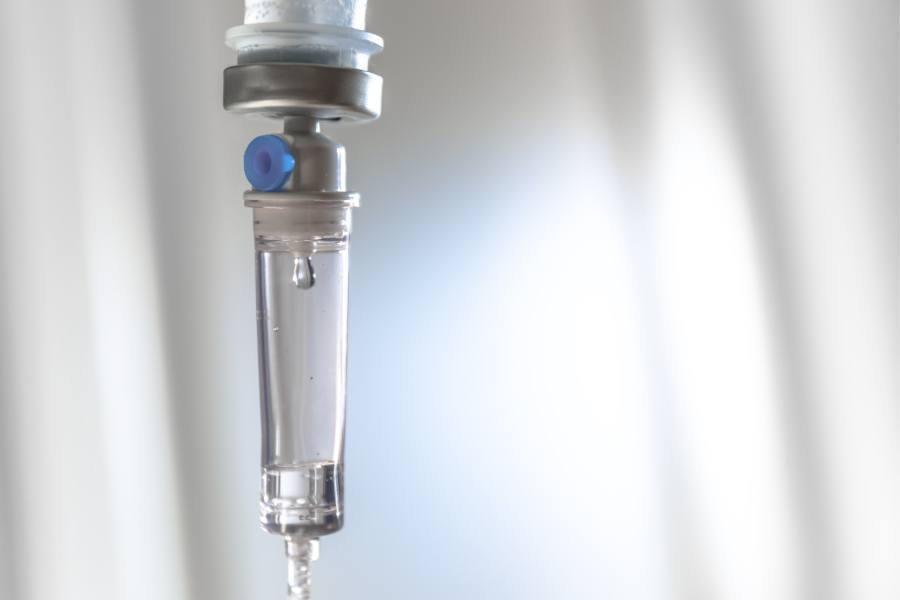Many medical professionals and researchers believe that the gas ozone might bring plenty of rejuvenating effects. This naturally occurring molecule could restore a human’s body vitality and strengthen the immune system when exposed to infections.
Let’s discover how does IV ozone therapy work and what are the benefits of using this type of intravenous therapy.

Source: shutterstock.com/ Photo Contributor: ANDRANIK HAKOBYAN
How Does IV Ozone Therapy Work
Viruses and bacteria have gotten used to the antibiotics present on the market and have evolved to be immune to them. Even though ozone therapy is mostly used to support the immune system in fighting illnesses, it can potentially act as a treatment protocol for common colds caused by viruses.
The medical ozone mixture is made out of both ozone and oxygen. The ozone-oxygen ratio is 0.05-5% of ozone and 95-99.95% of oxygen. When intravenously given through an IV drip concoction, this gas does several things to the human body that aid in quick health-benefit solutions.
When ozone is administered to a patient with a dosage between 30 and 55 gamma, it could result in a significant immune boost. This happens because of the protein interferon production, which helps fight off viruses. Speaking of viruses, IV ozone therapy may help in fighting t viruses, bacterial and yeast infections, fungi, and protozoa.
Ozone treatment may also boost the creation of red blood cells. All body parts receive oxygen from the lungs via red blood cells, which also deliver carbon dioxide back to the lungs for exhalation.
The History of Ozone Therapy
The biggest breakthrough regarding ozone therapy happened in 1896 because of Nikola Tesla. He patented the first ozone generator in America, known as the “Tesla Ozone Company.”
Ozone therapy was largely used during World War l, where doctors familiar with it used it as a topical treatment. Ozone was applied to open wounds to prevent bacterial infections. However, this treatment led to the discovery of three ozone properties: antibacterial, anti-inflammatory, and hemodynamic.
On the other hand, IV ozone therapy was developed during the 1950s. It was first used in Germany around the time.
Later in the 1980s, ozone therapy was tested with patients that had contracted HIV. The people of that time were anticipating an HIV pandemic; however, doctors experimented with ozone autohemotherapy, which proved an effective treatment aid to an extent.
In modern times, IV ozone therapy is the one of the most popular ways of administering ozone.
How IV Ozone Therapy is Performed
There are three ways you can receive ozone therapy. Which way is used on you depends on the reason you need ozone therapy. The three ways are the following:
Intramuscularly- ozone and oxygen are mixed together, and the mixture is injected directly into a particular muscle.
In the tissue- ozone is administered this way if you have an open wound or extremity problems.
Intravenously- the procedure is the same as a regular IV treatment. The difference between a regular IV mixture and IV oxygen treatment is that you receive oxygen through the blood.
When administered intravenously, a medical professional will take a small amount of blood, mix it with ozone and then infuse the substance into your bloodstream using an IV drip. This is the preferred method used at The Drip IV Infusion for Ozone Therapy.

Source: shutterstock.com/ Photo Contributor: ANDRANIK HAKOBYAN
Benefits and Side Effects
IV ozone therapy has major benefits but also a couple of shortcomings.
IV ozone therapy benefits
It has the potential to improve your immune system
It may reduce the likelihood of having another heart attack
It may increase the synthesis of white and red blood cells
It might aid in the repair of brain tissue following a stroke
It may reduce the amount of acid in your body
It has the potential to increase joint motion
It could help to cleanse the body of toxins
It may aid in the battle against infections
It might revitalize your skin and aid in anti-aging
Cellular energy generation is supposed to increase
It may reduce your body’s oxidation
It might remove viruses and bacteria
Ozone IV therapy side effects
Some light side effects that can appear are dizziness, lightheadedness, coughing, burning eyes, and nausea. However, these pass in less than an hour.
Another side effect that may occur is Herxheimer reaction or “healing crisis”. This phenomenon might occur during some medical treatments that fight against harmful microorganisms in the body. The manifestation of this reaction is typically through flu-like symptoms.
Which Illnesses IV Ozone Therapy Treats
Ozone could support the body in its fight against 114 different illnesses. This is possible since the treatment reacts as an anti-inflammatory drug. Therefore, where there is any kind of inflammation, IV ozone therapy might help.
Arthritis
Arthritis is classified into two types. Ozone therapy, on the other hand, is limited to rheumatoid arthritis (RA). Ozone therapy might help to alleviate the pain of rheumatoid arthritis, an inflammatory disorder that damages the joint.
Ozone has an effect on both antioxidants and cytokines. As a result, while ozone therapy could act as a supporting treatment for RA, it cannot totally cure the condition.
Cancer
There have been studies researching how ozone therapy might help in supporting the bodies fight against tumor hypoxia. Tumor hypoxia is a condition where cancerous cells are in need of oxygen. When cancerous cells are deprived of oxygen, the patient will require more chemotherapy and radiotherapy sessions.
Results from such studies have shown that ozone therapy might be a potential support to chemotherapy goals.
Musculoskeletal disorders
Ozone therapy may be an effective in aiding the bodies fight against various muscle and joint diseases. Such a disease is myofascial pain syndrome which is a joint disorder. The joints in question are the temporomandibular joints.
This disorder causes pain during talking and chewing, or any other activity involving the lower jaw. Ozone therapy might be more effective compared to other pain-release medications. It also might increase the level to which the patient can stretch open their mouth.
Ozone therapy may also aid in faster recovery of joints. Doctors suppose that this is due to the highly reactive nature of ozone. Ozone treatments might increase new cartilage growth, stimulate the repairing abilities of the fibroblastic joint, as well as reduce inflammation.
Bacterial infections
Two of the most important particles in human cells are lipoproteins and phospholipids. Lipoproteins are particles made up of protein and fats, while phospholipids have phosphor. Ozone therapy might decrease bacteria by oxidation of these two cell particles.

Source: shutterstock.com/ Photo Contributor: ImageFlow
Viruses
Ozone therapy as a supplemental treatment protocol for viruses might be effective because ozone disrupts the reproductive cycle of the virus. Ozone manages to inhibit the connecting process between the cell and the virus.
The enzyme coating on the cells in the first cell element that suffers when a virus enters the body. However, ozone manages to strengthen the enzyme wall, which makes the cells much healthier and more robust.
Yeast infections and Fungi
Ozone could manage to disrupt the work of infections in certain stages of the infection process, which prevents the infection from reaching its full form.
Studies surrounding ozone therapy as a body support protocol for candida infections suggest that ozone might help as a supplemental treatment in certain forms. Patients who have suffered from candida albicans have shown significant improvements in their condition after getting ozone therapy.
Protozoa
Protozoa are one-celled organisms that need a human host to reproduce. However, when they do, they slowly kill the host by causing many infections. Doctors may eliminate protozoa from the body in many ways, including ozone.
Ozone might be used best as a prevention of protozoa entering the body. These germs can get into the body mainly through food and water. Ozone has proven to be much more effective in ridding these germs from water than chlorine.
Chronic obstructive pulmonary disease
COPD is a collection of diseases that cause numerous breathing problems due to the inhibition of airflow. Because the airflow is blocked, the lungs will get overworked. They now have triple the work to make and distribute enough oxygen through your body.
Considering the high levels of oxygen in ozone, ozone therapy might help with COPD. The oxygen in the ozone might lessen the job of the lungs and supply your cells and organs with oxygen.
Fibromyalgia
Fibromyalgia is a chronic disease that causes chronic, long-lasting pain and fatigue in patients. Ozone therapy for fibromyalgia might help because the additional oxygen should help strengthen the immune system and lessens cortisol.
This reduces the symptoms of fatigue, pain, depression, and anxiety. However, ozone therapy doesn’t eliminate the illness entirely; rather, it could help to manage it.
Diabetes
Ozone therapy might help as a supplemental treatment protocol for diabetes by raising the number of red blood cells, which also betters blood circulation. Also, ozone could manage to boost the immune system and increase antioxidant levels.
How Long Does Ozone Therapy Take to Work
Ultimately, how long it will take for the IV ozone therapy to kick in will differ from person to person and depend on the illness a patient might have. Also, the dosage will be different depending on the situation.
On average, patients need from six to ten IV ozone sessions to experience significant changes. Studies show that the mortality risk in patients that have received seven consecutive ozone therapy sessions has lowered. Considering this, you might be able to see improvements in your overall health before you would’ve completed all your Ozone sessions.
How long does IV ozone stay in the body
Intravenously injected ozone can stay in the body for up to a week. However, that doesn’t mean that the effects of ozone therapy disappear after a week. In the best-case scenario, the effects of IV ozone therapy might be permanent, but it depends on the person’s lifestyle and illness.

Source: shutterstock.com/ Photo Contributor: Numstocker
Frequently Asked Questions
How do you feel after getting IV ozone therapy?
A study by the National Library of Medicine has found that patients mostly feel tired after four to five treatments. These reports were given by 30% of adult men and women out of the total 100% of patients.
On the other hand, 50% of patients reported that they feel energized and healthy, while the remaining 20% had no mention-worthy feelings.
What does IV ozone therapy do to the brain?
Studies suggest that IV ozone therapy may increase blood flow to the brain at a steady rate. This is supposed to allow the brain to get all vital nutrients as well as achieve optimum levels of oxygen.
How much is the average cost of IV ozone therapy in the USA?
Insufflation ozone is the cheapest out of all ozone therapies which ranges from $100-$250. On average, ozone treatments can cost from $100-$1000.
Who is a good candidate for ozone therapy?
Patients who don’t respond well to antibiotics may be good candidates for IV ozone therapy. Also, those patients who suffer from breathing problems may be suitable candidates for an IV ozone treatment. Patients with chronic illness and/or that conventional/western medicine has not been able to figure out.
Conclusion
We hope this article has helped you find how does IV ozone therapy work. Initially, this kind of therapy could help in eliminating the harmful bacteria and viruses by boosting our immune system. Moreover, it might support energy production, tissue repair process, detoxification, and possibly reduce oxidative stress.
So much has been found out about what ozone can do for human health, and medical professionals claim that all of this is just the tip of the iceberg. Just imagine what the future holds for the health of humanity using IV ozone therapy.




